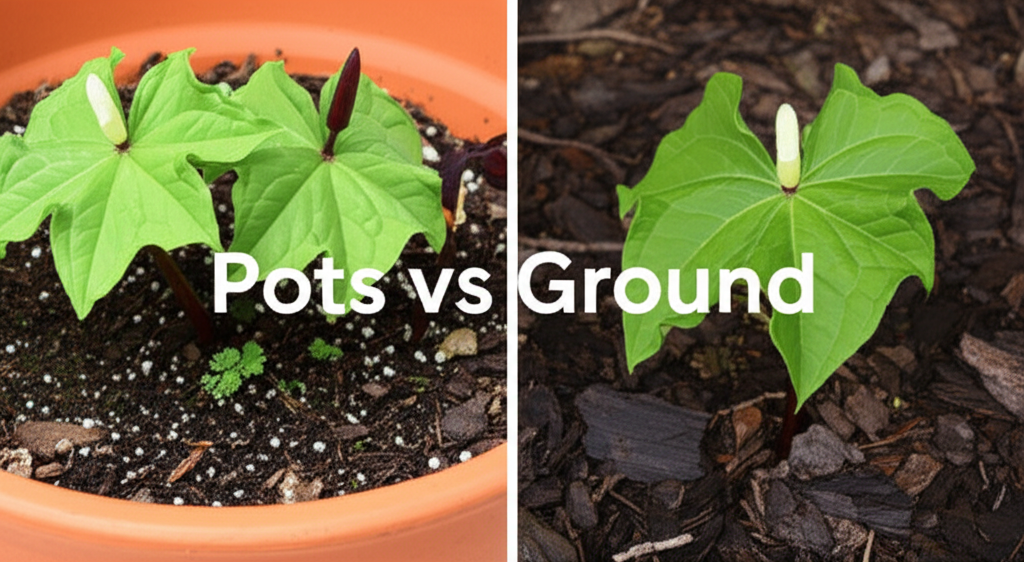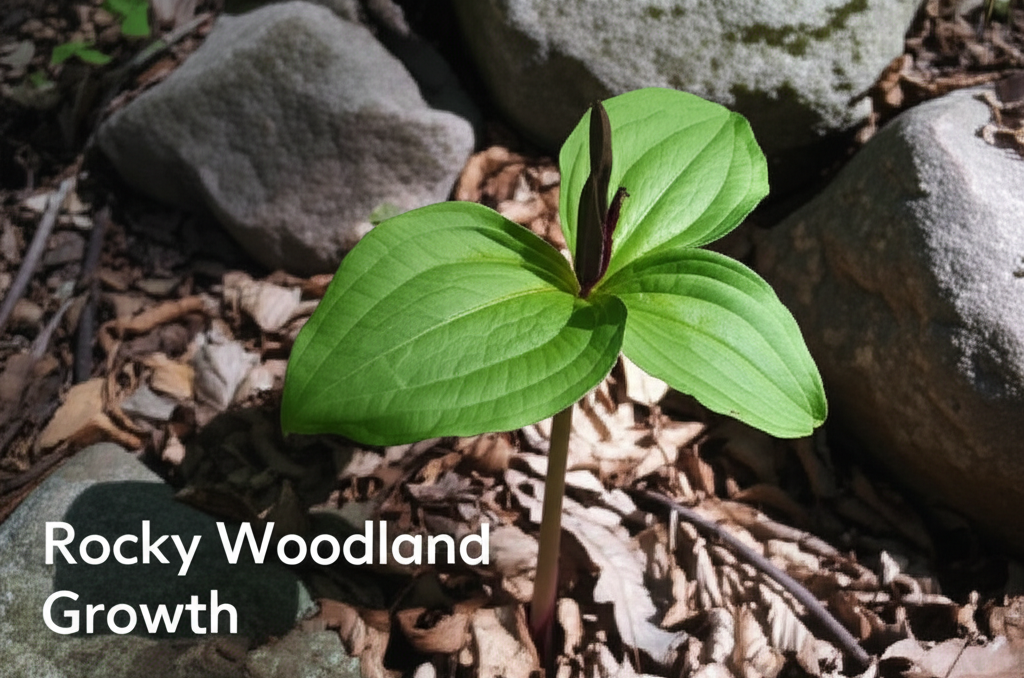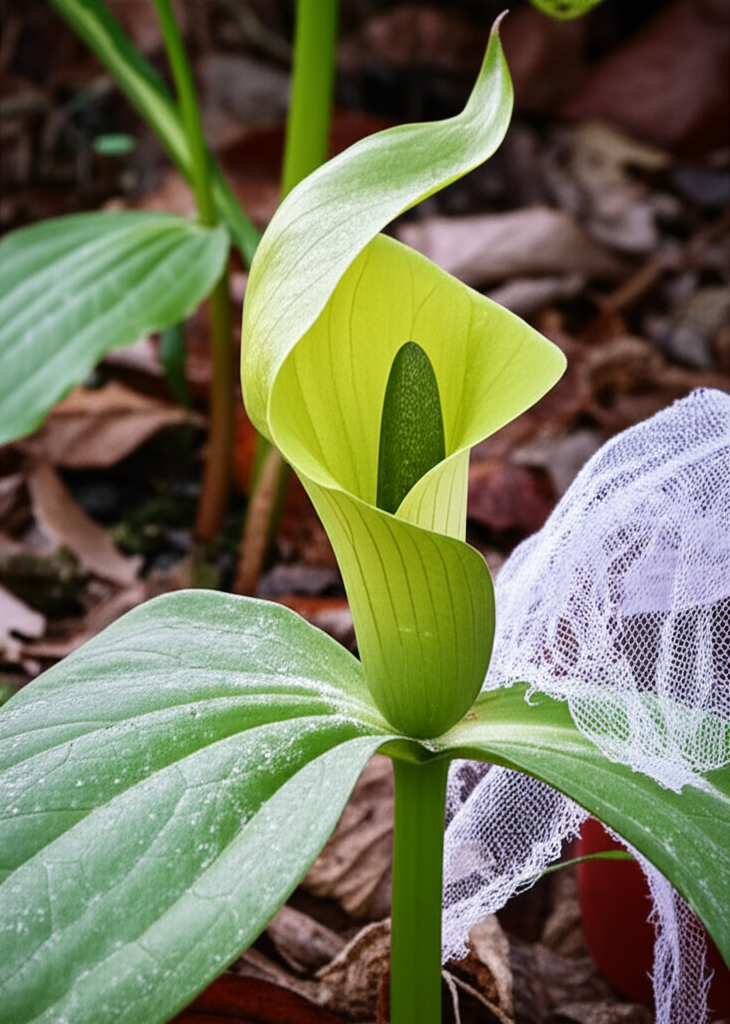Mastering the Enigmatic Jack-in-the-Pulpit: Pot vs. Ground Cultivation
The Jack-in-the-Pulpit, Arisaema triphyllum, is a botanical marvel, instantly recognizable by its hooded spathe and spadix, reminiscent of a preacher delivering a sermon from a pulpit. This native woodland perennial, a member of the Araceae family (which also includes familiar houseplants like peace lilies and anthuriums), thrives in the dappled shade of deciduous forests, moist soils, and rich organic matter. Its unique appearance and fascinating life cycle—including its ability to change sex—make it a sought-after addition to shady gardens. However, aspiring cultivators often face a crucial decision: should they plant their Jack-in-the-Pulpit in the ground or opt for container gardening? Each method presents distinct advantages and challenges, influencing the plant’s growth, health, and overall success. This comprehensive guide will delve into the intricacies of growing Arisaema triphyllum in both environments, equipping you with the knowledge to make the best choice for your circumstances and ensure your own little preacher thrives.
Understanding the Jack-in-the-Pulpit’s Natural Habitat
Before we compare pot versus ground cultivation, it’s essential to understand the plant’s native environment. Jack-in-the-Pulpit is a woodland understory plant. This means it naturally grows in:
- Dappled Shade: It prefers indirect sunlight, typically found beneath the canopy of mature trees. Direct sun, especially in the afternoon, can scorch its leaves.
- Moist, Well-Drained Soil: While it enjoys consistent moisture, it dislikes waterlogged conditions that can lead to corm rot. Its natural habitat often features moist, humus-rich soils that drain well.
- Rich Organic Matter: Decaying leaves and other organic debris in forests provide essential nutrients and improve soil structure, mimicking the ideal conditions for Jack-in-the-Pulpit.
- Protection from Wind: Its delicate foliage can be damaged by strong winds, so sheltered locations are beneficial.
These environmental cues are vital when considering how to best replicate them in a garden setting, whether in a pot or directly in the soil.
Cultivating Jack-in-the-Pulpit in the Ground

Planting Jack-in-the-Pulpit directly into your garden offers a more naturalistic approach, allowing the plant to establish a more robust root system and integrate seamlessly into a woodland garden setting.
Site Selection and Preparation
The success of ground-planted Jack-in-the-Pulpit hinges on choosing the right location and preparing the soil.
Ideal Locations:
- Beneath deciduous trees that provide seasonal shade.
- On the north or east side of buildings or larger shrubs.
- Areas that naturally retain moisture but do not become boggy.
Soil Preparation:
The goal is to replicate the rich, moist, well-draining woodland soil.
- Test Drainage: Dig a hole about a foot deep and fill it with water. If the water drains within a few hours, your drainage is adequate. If it pools, you’ll need to amend the soil.
- Amend the Soil: Incorporate generous amounts of organic matter. This can include compost, well-rotted leaf mold, or aged manure. Aim for a soil mix that is at least 30-40% organic material.
- Adjust pH: Jack-in-the-Pulpit prefers slightly acidic to neutral soil (pH 5.5-7.0). If your soil is alkaline, adding peat moss or elemental sulfur can help lower the pH.
- Loosen the Soil: Ensure the soil is loose to allow for easy root penetration and aeration. Double digging or adding coarse sand can improve aeration in clay soils.
Planting the Corm
Jack-in-the-Pulpit corms are typically planted in the fall or early spring.
- Planting Depth: Plant the corms about 4-6 inches deep, with the top of the corm pointing upwards.
- Spacing: Space plants 6-12 inches apart to allow for mature growth and air circulation.
- Mulching: Apply a layer of mulch (leaf mold, shredded bark, or pine straw) around the base of the plant. This helps retain moisture, suppress weeds, and insulate the soil.
Ongoing Care in the Ground
Once established, Jack-in-the-Pulpit in the ground requires relatively minimal care.
- Watering: Water consistently, especially during dry spells. Aim for moist, but not waterlogged, soil. The plant is generally more drought-tolerant once established, but consistent moisture promotes better flowering and fruiting.
- Fertilizing: In the ground, they often require little to no supplemental fertilizer if planted in rich soil. A top dressing of compost in the spring is usually sufficient.
- Weeding: Keep the area around the plants free of weeds, which compete for water and nutrients. Mulching greatly aids in weed suppression.
- Pest and Disease Management: Generally resistant, but slugs and snails can be an issue. Signs of rot suggest overwatering.
Advantages and Disadvantages of Ground Planting
Here’s a summary of the pros and cons:
| Advantages | Disadvantages |
|---|---|
| More naturalistic appearance and integration into landscape. | Less control over soil conditions, drainage, and light. |
| Deeper root system for greater resilience and drought tolerance once established. | Can be harder to monitor and manage pests/diseases. |
| Lower maintenance once established. | Requires careful site selection to match specific light and moisture needs. |
| Less need for frequent watering compared to containers. | Can be susceptible to competition from aggressive nearby plants. |
| More suitable for larger plantings and creating a woodland effect. | Difficult to move if conditions change or you relocate. |
Cultivating Jack-in-the-Pulpit in Pots
Container gardening offers a unique set of benefits, particularly for those with limited garden space or challenging soil conditions. It provides greater control over the plant’s environment.
Choosing the Right Pot and Potting Mix
The container itself and the medium within it are critical for success.
Pot Selection:
- Size: Choose a pot that is at least 8-10 inches in diameter and depth. This allows ample room for the corm to grow and for a healthy root system to develop. A larger pot is always preferable to prevent water drying out too quickly.
- Material: Terracotta pots offer good aeration but can dry out quickly. Plastic or glazed ceramic pots retain moisture better. Ensure the pot has adequate drainage holes.
- Drainage: This cannot be stressed enough – drainage is paramount. Even in pots, waterlogged conditions will lead to corm rot.
Potting Mix:
A high-quality, well-draining potting mix is essential.
- Base: Use a peat-based or coco coir-based potting mix.
- Amendments: Incorporate perlite or coarse sand (about 20-30%) to improve drainage and aeration.
- Organic Matter: Add compost or leaf mold to provide nutrients and improve soil structure. A good mix might be 2 parts potting mix, 1 part compost, and 1 part perlite.
Planting and Potting Mix
Similar to ground planting, corms are best planted in fall or early spring.
- Layering: Place a layer of potting mix at the bottom of the pot.
- Corm Placement: Position the corm about 4-6 inches deep, with the pointed end up.
- Backfilling: Fill the rest of the pot with the prepared potting mix, leaving about an inch of space at the top for watering.
- Watering: Water thoroughly after planting to settle the soil.
Ongoing Care in Pots
Container-grown Jack-in-the-Pulpit require more attentive care due to their confined environment.
- Watering: This is the most crucial aspect. Check the soil moisture regularly by inserting your finger about an inch deep. Water when the top inch feels dry. Avoid letting the pot sit in a saucer of water for extended periods. Watering frequency will depend on the pot size, material, temperature, and humidity.
- Light: Place the pot in a location that receives bright, indirect light. A few hours of morning sun is usually acceptable, but avoid intense afternoon sun.
- Fertilizing: Feed your potted Jack-in-the-Pulpit with a balanced liquid fertilizer diluted to half strength every 4-6 weeks during the active growing season (spring and early summer). Avoid over-fertilizing, which can burn the roots.
- Repotting: As the plant grows, it will eventually outgrow its pot. Signs include roots emerging from drainage holes or the plant drying out very quickly. Repot into a larger container every 2-3 years in the fall or early spring.
- Dormancy: Like many woodland plants, Jack-in-the-Pulpit goes dormant in late summer or fall. The foliage will yellow and die back. At this point, you can reduce watering and move the pot to a cooler, shaded location, or even a cool garage or basement for the winter. Water sparingly during dormancy, just enough to prevent the corm from completely drying out.
- Pests and Diseases: Slugs and snails are common pests in containers. Root rot is the primary disease concern, stemming from overwatering. Ensure good air circulation around the pot.
Advantages and Disadvantages of Pot Planting
Here’s a breakdown of the pros and cons of container growing:
| Advantages | Disadvantages |
|---|---|
| Greater control over soil, light, and moisture levels. | Requires more frequent watering and attention. |
| Ideal for small spaces, balconies, or patios. | Plants can become root-bound and need repotting. |
| Easier to move to optimal locations as seasons change or to protect from harsh weather. | Can dry out quickly, especially in hot weather or with porous pots. |
| Protection from aggressive garden plants or soil-borne diseases. | Nutrients can leach out more quickly, requiring more frequent fertilization. |
| Can be brought indoors or to a protected area during dormancy. | Aesthetics might be less naturalistic compared to in-ground planting. |
Key Differences and Decision Factors
Choosing between pot and ground cultivation for your Jack-in-the-Pulpit ultimately depends on your specific gardening situation and preferences.
Comparison Summary
| Feature | Ground Cultivation | Pot Cultivation |
| :————— | :———————————————– | :———————————————— |
| Space | Requires dedicated garden space. | Versatile for small spaces, balconies, patios. |
| Control | Less control over soil, light, and moisture. | High control over all environmental factors. |
| Watering | More natural rainfall reliance, less frequent. | Requires frequent checking and watering. |
| Fertilizing | Minimal, relies on soil fertility. | More frequent feeding needed. |
| Maintenance | Lower, once established. | Higher, due to watering, feeding, and repotting. |
| Aesthetics | Naturalistic, integrates into landscape. | Can be more structured, controlled presentation. |
| Root System | Deeper, more robust, greater resilience. | Confined, requires management. |
| Winter Care | Relies on natural insulation of surrounding soil. | Can be moved to protected locations for winter. |
| Dormancy | Foliage dies back in place. | Foliage dies back, plant can be moved. |
| Pest/Disease | Generally less prone, but competition exists. | More susceptible to root rot (overwatering), slugs. |
Factors to Consider When Making Your Choice
- Available Space: Do you have a suitable shady spot in your garden, or are you limited to containers?
- Soil Conditions: Is your native soil suitable for woodland plants, or would it require extensive amendment? If your soil is heavy clay or very sandy, containers might be a better option.
- Time Commitment: Are you looking for a low-maintenance plant, or do you enjoy the process of detailed plant care?
- Climate: If you experience extremely harsh winters or dry summers, container growing allows for greater protection and control.
- Desired Aesthetic: Do you want a natural woodland feel, or a more curated display in a pot?
Conclusion: The Best of Both Worlds
Both ground and container cultivation can lead to successful and beautiful Jack-in-the-Pulpit plants. The “best” method is entirely subjective and dependent on your individual gardening circumstances. If you have the ideal garden conditions—consistent dappled shade, moist, well-draining soil rich in organic matter—then planting directly in the ground offers a more naturalistic and less demanding approach. The plant will establish a strong root system, requiring less intervention once it’s settled.
Conversely, if you have limited space, less-than-ideal soil, or simply desire greater control over your plant’s environment, container gardening is an excellent alternative. It allows you to create the perfect microclimate for your Jack-in-the-Pulpit, ensuring it receives precisely the right amount of light, moisture, and nutrients. The ability to move potted plants for protection or to showcase them makes them incredibly versatile.
Whichever method you choose, remember that the Jack-in-the-Pulpit is a rewarding plant to grow. Its unique beauty and intriguing life cycle are sure to bring a touch of wild enchantment to your garden, whether it’s gracing a shady corner of your yard or gracing a stylish pot on your patio. By understanding its needs and tailoring your care to its chosen environment, you can ensure this enigmatic woodland dweller thrives for years to come.


